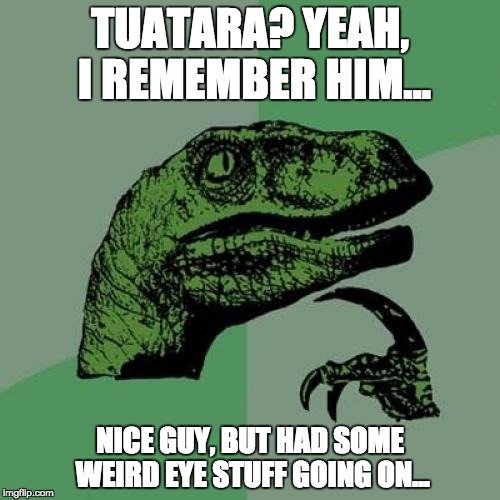Table of Contents (click to expand)
Yes, but it is more commonly called a parietal eye, and is only found in certain species of lizards, sharks, bony fish, salamanders and frogs. It typically doesn’t see, but is instead photoreceptive in nature.
The last time you found yourself in an intense conversation with a very “spiritual” person at a bar,discussing chakras, energy and different planes of existence, there’s a good chance they may have mentioned their “third eye”. In most cases, the idea of a third eye is symbolic, but it does raise the question… are there any animals that actually possess a third eye?
Short Answer: Yes, but it is more commonly called a parietal eye, and is only found in certain species of lizards, sharks, bony fish, salamanders and frogs. It typically doesn’t see, but is instead photoreceptive in nature.
The History Of The Third Eye
While the idea of humans having a third eye seems crazy – and impossible – if we go far enough back in our evolutionary history, there was a point where it could have actually happened. When our fish-like predecessors were developing, this trait was a dividing point – a branch in the great evolutionary tree – and we left it behind. Had mammals and all other vertebrates not gone the way of symmetry, we could have benefitted from being able to look at the world above us. Some animals still get to enjoy a “third” eye, but it doesn’t have quite the same function as the other eyes that we have all come to appreciate and recognize.
In fact, human beings still have the evolutionary remnant of that third eye, but it is buried deep in the brain, and is known as the pineal gland. It is very important for hormone regulation in mammals and vertebrates. For other animal species, far removed from human beings, the pineal gland is just one half of the epithalamus. At a certain point in evolutionary history, having a sensitive point on top of the head was selected in some creatures, but not in others. The subsequent structure, known as the epithalamus, is composed of the epiphysis (the pineal gland in humans, or pineal organ in other species) and the parietal organ (the “third eye”).

When we look back through the fossil record, some of the oldest vertebrates do appear to have a socket on the top of their head where a third eye could have ostensibly been located; this socket can still be seen in the bone structure of certain amphibians and reptiles, but it disappeared long ago in birds and other mammals.
While this two-part organ is not found in any mammals, it is quite common in various species of lizards, frogs, bony fish, sharks and salamanders. However, it does not function in the same way as the main eyes that provide animals with the power of sight. The parietal eye is essentially just a spot on their head that is receptive to light, which means that it is somewhat sensitive to movement and the changes in light that occur when something moves through an environment. Even for those few species and animal types that possess this “third eye”, it is typically covered by a layer of skin, is difficult to spot with the naked eye, and is much smaller than the front-facing eyes.
Also Read: Do Jellyfish Have Eyes?
Will All Animals Eventually Lose This Third Eye?
It is difficult to predict the direction that evolutionary history will go, and there are always some species that seem to slip through the cracks of time, maintaining old adaptations for hundreds of millions of years longer than their long-extinct cousins. When it comes to the pineal eye, for example, the animal with the most pronounced “third eye” is actually the tuatara, an ancient lizard endemic to New Zealand. This lizard is a remnant from the Rhynchocephalia order, which flourished roughly 200 million years ago, but is now completely extinct, except for this one type of lizard.

The tuatara has a well developed parietal eye, which actually has a lens and a retina. It is most clearly visible in young tuatara, before a thin layer of skin grows over the top, but it is able to detect light very well, and helps this lizard-like reptile determine seasonal and temporal changes. In the case of the tuatara, the eye still serves its original function, and there is no clear reason why it would ever disappear. Again, natural selection is a highly unpredictable force.
In other animals, such as lampreys, some of the most primitive creatures still present on Earth, two parietal eyes are present, one from the parietal gland and the other from the pineal gland. These two eyes are lined up on top of the head, similar to where the single parietal eye is now located in invertebrate and reptile species. Due to lampreys ancient status, some researchers believe this was the original orientation for all “third eyes”, which gradually shifted to having only one, and then eventually to none.
The number of eyes in animals is not fixed, nor is there a right or wrong number for an animal to have. Arachnids, for example, have 8 eyes, with pairs that serve different purposes (e.g., some for detail, some to perceive movement, etc.). Praying mantises have 5 eyes, as do many other insects, with two large compound eyes complemented by three smaller eyes that detect light, similar to the parietal eye discussed above.
Finally, some animals on the sea floor – where evolutionary adaptation gets truly strange – have even more bizarre visual arrangements. Starfish have eyes at the end of every arm, giving them a wide field of 360-degree vision, while some bivalves, such as clams, can have thousands of photoreceptor eyes on the surface of their mantle. Some scallops can also have more that 100 sophisticated reflector eyes, resembling a spherical concave mirror, that actually allow them to “see” – and even swim!
Clearly, eyes come in all shapes, sizes, configurations and functions, and that isn’t likely to change anytime soon. The next time someone cracks a joke about their third eye being blind, you can explain that they still have the basic structure of a third eye (pineal gland), but it sunk further down into the brain to serve a different, more important purpose!
Also Read: Is There An Evolutionary Advantage To Different Shapes Of Eye Pupils?
How well do you understand the article above!

